Extinction is a natural process that would happen with or without humans. It has been happening long before humans came on the scene. However, research has shown that many species are disappearing faster than expected due to human activities. In America, one-third of the country’s wildlife is at risk of extinction, and many of these endangered animals call Ohio home.
Loss of habitat, pollution, and indiscriminate hunting and killing of animals are among the biggest causes of extinction. To reverse some of these damages and help “at-risk” animal species recover, governments worldwide are investing efforts into protecting vulnerable species. In Ohio, certain legal measures are in place to protect endangered species and help them thrive. The following are some of the endangered animals in Ohio that you should know.
1. Allegheny Woodrat (Neotoma magister)
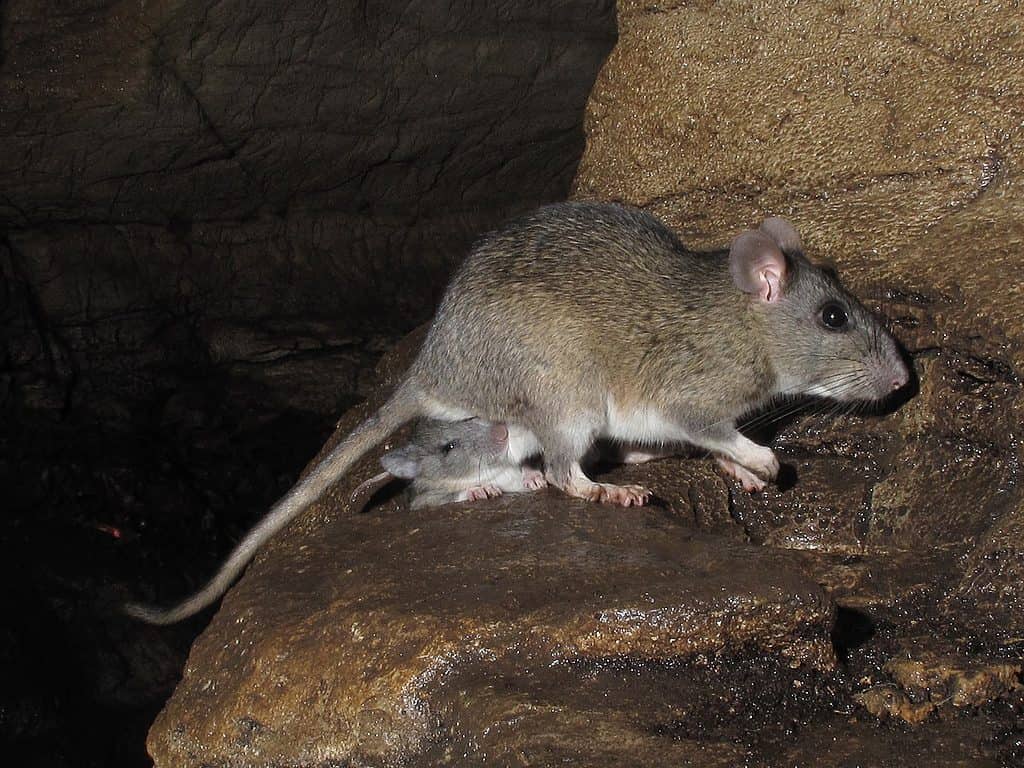
An adult Allegheny
woodrat
is 15 to 18 inches long, including a seven-inch long tail.
©Alan Cressler / CC BY-SA 2.0 – License
The Allegheny woodrat is a harmless animal that spends its nights searching for food and looking for nesting materials. This rat species lives in rocky regions around cliffs and mountain ridges away from humans. An adult Allegheny woodrat is 15 to 18 inches long, including a seven-inch long tail.
The small, brownish-gray Allegheny woodrat has been listed as an endangered animal in Ohio since 1974. Despite best efforts, the species population has continued to drop. The last major population of the woodrats left in Ohio lives in Adams County. Experts blame the raccoon roundworm (which is fatal to the woodrat) as a major cause of the population’s decline. The loss of an important food source (the American chestnut) to chestnut blight is another factor contributing to the decline of the Allegheny woodrat in Ohio.
2. Indiana Bat (Myotis sodalis)
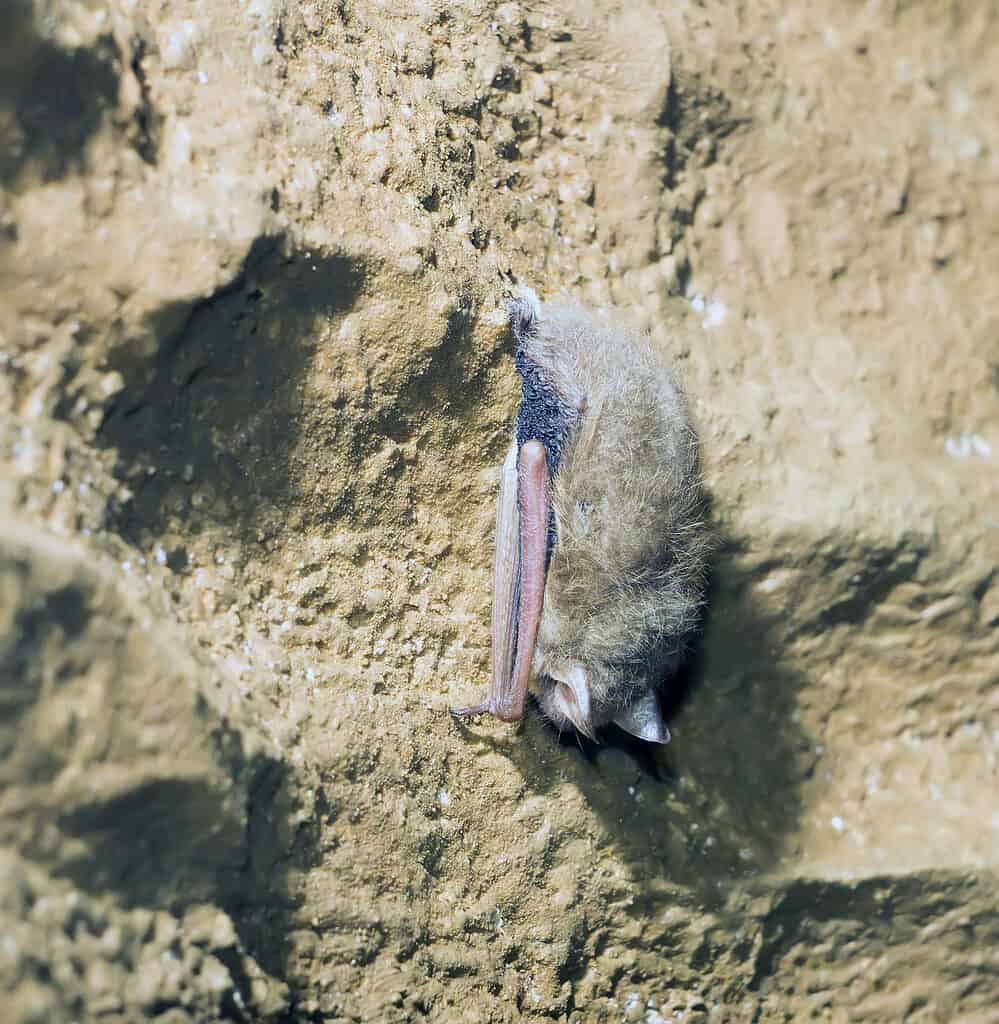
In Ohio, the Indiana
bat
lives in wooded areas during the summer but migrates to the warm caves of the southern Countries to hibernate during the winter.
©IrinaK/Shutterstock.com
The Indiana bat is listed as an endangered animal in both federal and state lists of endangered species. This bat is one of the 13 species of bat recorded in Ohio, and it is also one of the rarest. It is mostly dark brown but may also be gray or chestnut with dark brown wing membranes.
In Ohio, the Indiana bat lives in wooded areas during the summer but migrates to the warm caves of the southern Countries to hibernate during the winter. However, human disruption of these overwintering caves has affected the species’ survival. The Indiana bat is a nocturnal animal that feeds on insects like moths, beetles, and caddisflies. Experts believe using pesticides for gardening and agricultural purposes kills off insects that the bat would normally feed on, further putting the Indiana bat population at peril.
3. Timber Rattlesnake (Crotalus horridus)
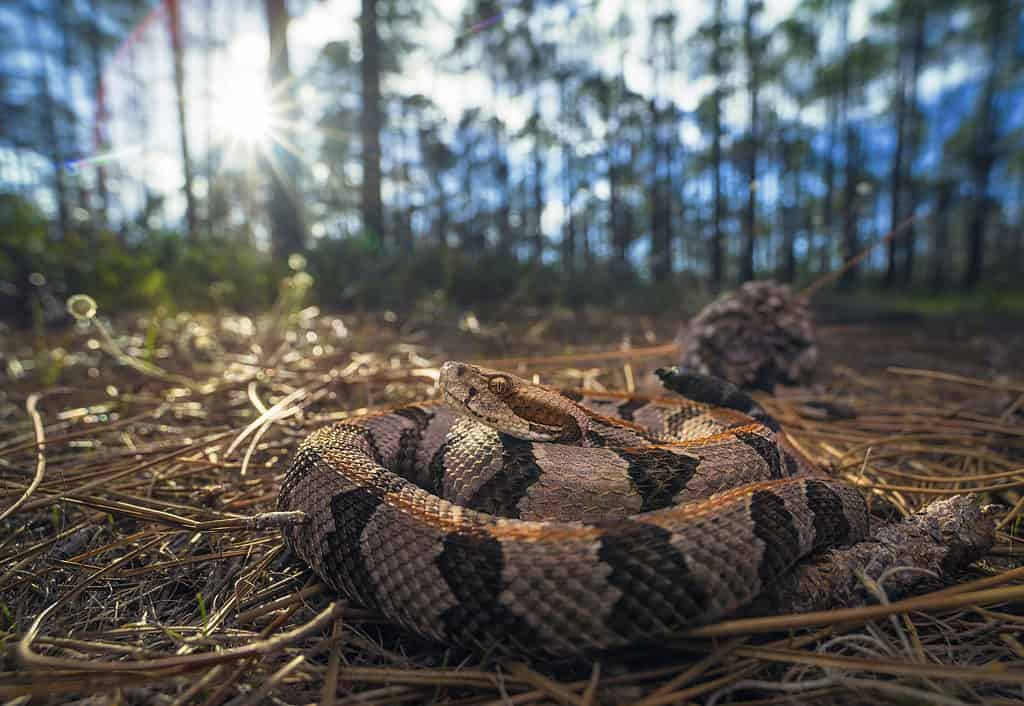
Historically, timber
rattlesnakes
used to be quite common in Ohio.
©Kristian Bell/Shutterstock.com
The timber rattlesnake is the most venomous snake in Northeastern America. Yet, despite their fearsome reputation, this snake species is not aggressive towards humans. In fact, snake bites are unheard of in Ohio, even in typical timber rattlesnake territory. This snake can grow to over three feet long. This beautiful reptile has dark and light brown bands running to the end of its tail.
Historically, timber rattlesnakes used to be quite common in Ohio. At some point, their range covered over 25 counties. Now, you can only see them in eight counties. Humans are the major reasons this snake species is going extinct. Timber rattlesnakes prefer dry, wooded hill places where they prey on a variety of small warm-blooded animals. The loss of this habitat due to human activities and fragmentation is the leading cause of the species’ decline.
4. Pirate Perch (Aphredoderus sayanus)

The Pirate Perch is renowned for the bizarre positioning of its anal opening, which is closer to the front to the front of its body than other
fishes
.
©Ellen Edmonson and Hugh Chrisp / public domain – License
Pirate Perch was eradicated from Ohio for nearly 50 years before the Ohio Division of Wildlife re-introduced it in the late 1990s. This small, dark-colored fish is renowned for the bizarre positioning of its anal opening, which is closer to the front to the front of its body than other fishes.
In places where they’re found, the pirate perch typically hides in dense vegetation or organic debris and comes out to feed at night. This species was once abundant in Ohio, especially in the Great Black Swamp, Northwest Ohio. A healthy population also lived in the Maumee River Basin in Ohio. However, the draining of these marshes and swamp land for agricultural purposes destroyed their habitat.
This species probably disappeared in the early 1950s. But in 1997, 250 pirate perch species were restored to the upper Auglaize River area. A stable population now lives in the waterways of Northeastern Ohio, but they still need to be protected to allow them to thrive and extend their range.
5. Shovelnose Sturgeon (Scaphirhynchus platorynchus)
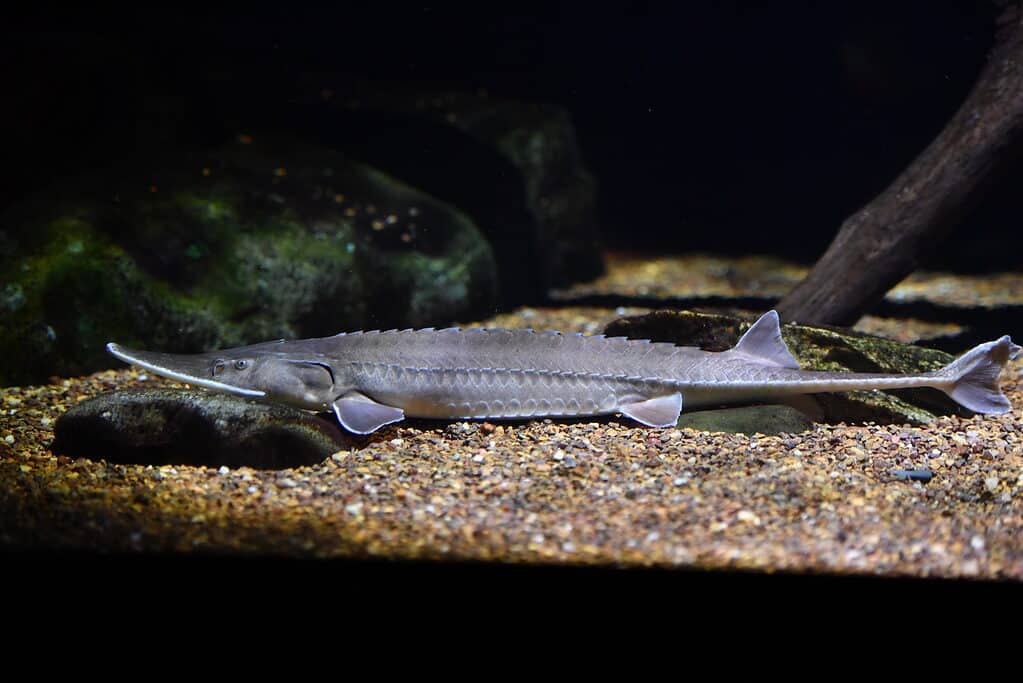
The shovelnose
sturgeon
was once abundant in the Ohio River, all the way upstream to the Pennsylvania Line.
©Andrea Izzotti/Shutterstock.com
Based on the name alone, the shovelnose sturgeon is hard to miss. The name is descriptive of the species’ flat “shovel-shaped” nose. The shovelnose sturgeon is a member of the Acipenseridae (sturgeons) family. It is one of two sturgeon species that call the waters of Ohio home. It is also the smallest sturgeon in North America.
Shovelnose is a large river species that prefer sand and gravel surface with fast current. The shovelnose sturgeon was once abundant in the Ohio River, all the way upstream to the Pennsylvania Line. However, their population began to drop after 1910, when the river was dammed. Today, the shovelnose sturgeon is rare in Ohio.
Only a small population of this fish can be found in the Ohio River from Portsmouth to the Indiana Line and the lower Scioto River. In addition to damming, pollution and the loss of its primary food source of mussels and snails are the major factors responsible for the species’ decline.
6. American Burying Beetle (Nicrophorus americanus)
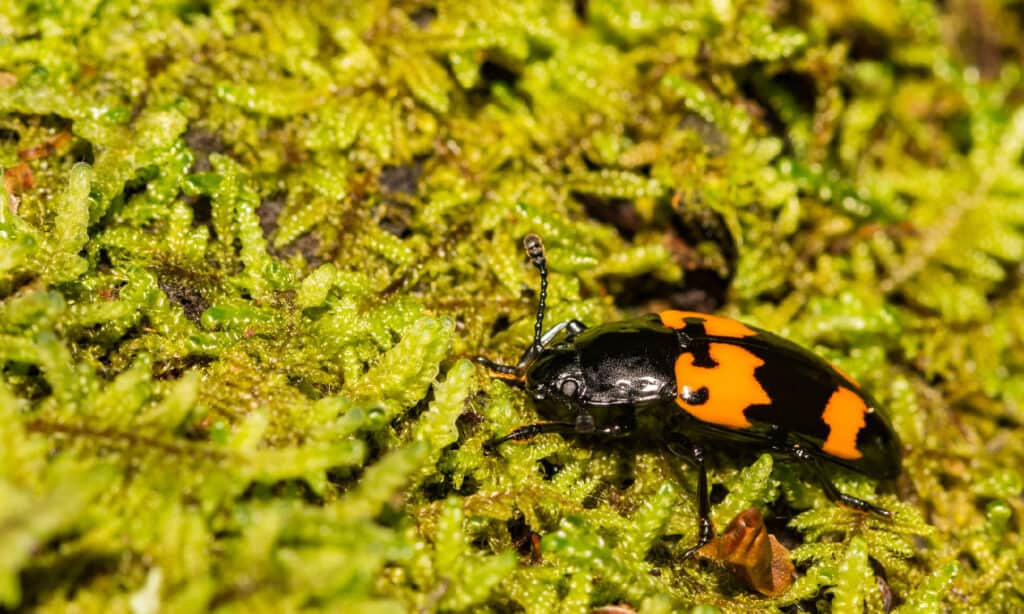
Once distributed throughout Ohio, the American burying beetle is listed as endangered at the federal and state levels.
©iStock.com/JasonOndreicka
The American burying beetle is also called the carrion beetle because it feeds on decaying plants and animals. Interestingly, the species also need carrion to breed. The American burying beetle is about an inch and a half long, with a black, shiny body. The wing covers have orange-red markings that give the beetle a unique appearance.
Once distributed throughout Ohio, the species is listed as endangered at the federal and state levels. In fact, it is the first insect to make the federal list of critically endangered species. Experts think habitat loss and dwindling food sources are responsible for the beetle’s decline. Light pollution, competition from larger scavengers, and increased pesticide use are among the factors contributing to their disappearance.
7. Common Tern (Sterna hirundo)
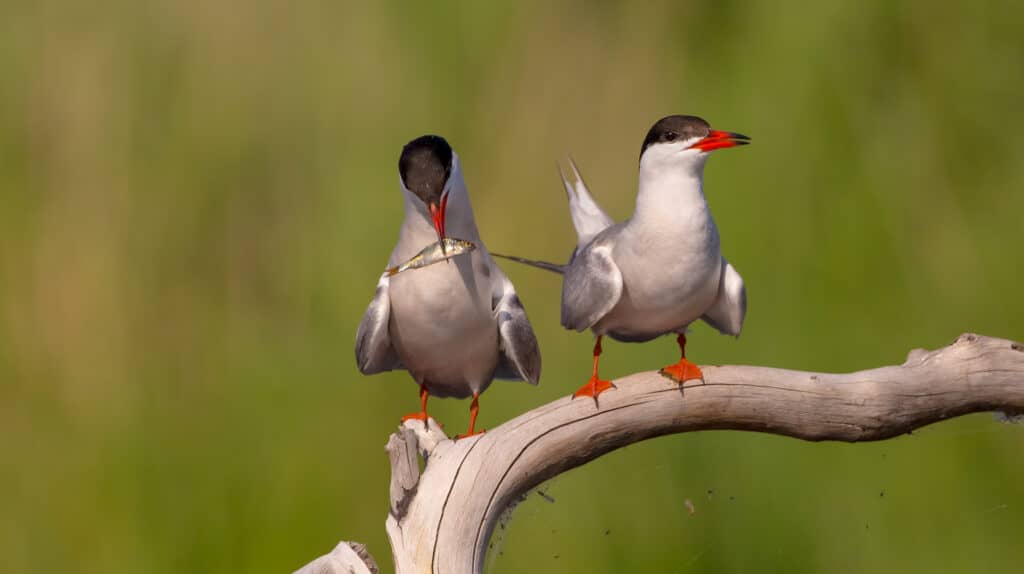
Common tern eggs and young are vulnerable to predators, such as
owls
, gulls, and raccoons.
©Simonas Minkevicius/Shutterstock.com
At some point, the common terns were truly common in Ohio until the larger, more aggressive gulls kicked them out of their nesting sites on the Lake Erie Islands. They’re among the endangered animal species in Ohio as they’re at risk of disappearing completely.
Interestingly, this isn’t the first time the species is under threat of extinction in Ohio. At some point during the 19th century, the bird’s population was completely decimated due to hat-making activities for which their feathers were used. However, the population bounced back after the bird received protection. Although they thrived through much of the 1900s, Common terns are now an endangered species in Ohio. Common tern eggs and young are vulnerable to predators, such as owls, gulls, and raccoons. As part of an effort to aid their recovery, artificial nesting platforms built along Lake Erie successfully attract these birds to more secure nesting areas.
8. Lark Sparrow (Chondestes grammacus)
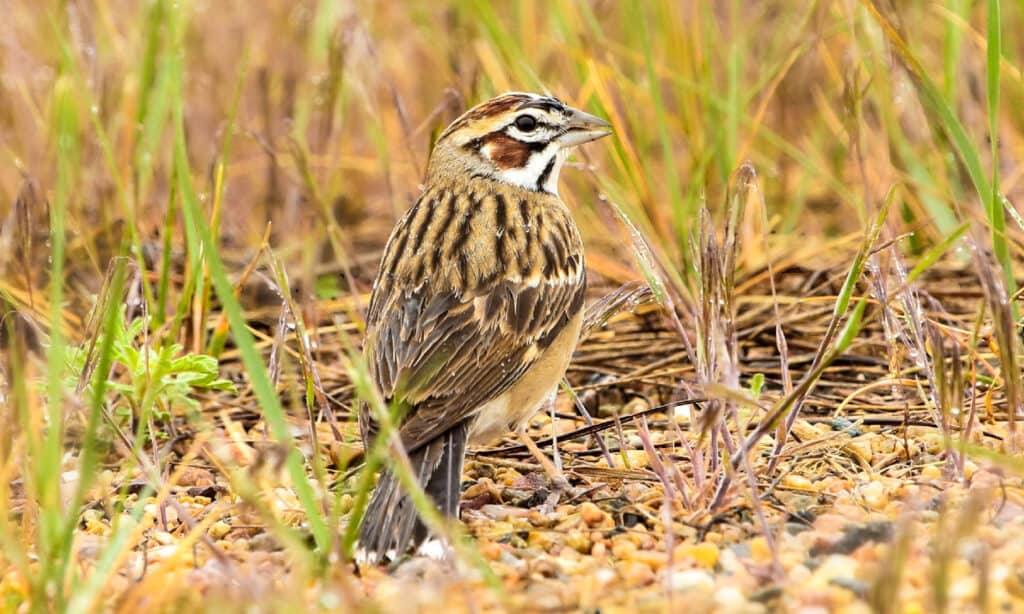
Though their population remains stable in the western part of the United States, the lark
sparrows
have experienced a reduction in Ohio.
©iStock.com/Nancy Strohm
Lark sparrows only visit Ohio to nest and raise their young during spring and summer. Afterward, they migrate to the southern part of the United States and Mexico during winter.
Though their population remains stable in the western part of the United States, the lark sparrows have experienced a reduction in Ohio. Conservationists have attributed their decline to fragmentation and habitat loss. This bird species nests in open grassy habitats, quickly disappearing due to human development and agriculture.
Their numbers declined during the 1930s and accelerated as the years went by. By 1965, the lark sparrows quietly disappeared except for small remnant populations in Adams and Lucas counties in Ohio.
Conclusion
In Ohio, as with many other locations in the world, many animals are going extinct or facing major extinction risks. Unless individuals and relevant agencies ramp up efforts to save these endangered animals that call Ohio home, we might end up losing them, and that’s bad for the planet’s ecosystem.
Up Next
- Discover 4 Endangered Creatures That Live in North Carolina
- 15 Endangered Species in Texas
- 5 Extinct Types of Spiders – And 3 Critically Endangered Spiders that Need Help Today
The photo featured at the top of this post is © Dennis Riabchenko/Shutterstock.com
Sources
- iNaturalist Network , Available here: https://www.inaturalist.org/guides/3788
- Cleaveland.com, Available here: https://www.cleveland.com/metro/2016/09/ohios_endangered_species.html
- The Nature Conservancy, Available here: https://www.nature.org/en-us/about-us/where-we-work/united-states/ohio/stories-in-ohio/ohio-endangered-species/
Thank you for reading! Have some feedback for us? Contact the AZ Animals editorial team.






